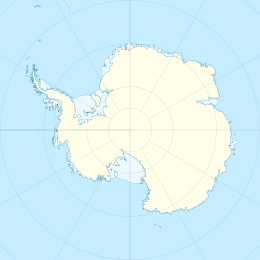Rothschild Island
 | |
| Geography | |
|---|---|
| Location | Antarctica |
| Coordinates | 69°36′S 72°33′W / 69.600°S 72.550°W |
| Area | 700 km2 (270 sq mi) (approximately)[1] |
| Length | 39 km (24.2 mi) |
| Administration | |
| Administered under the Antarctic Treaty System | |
| Demographics | |
| Population | Uninhabited |
Rothschild Island is a black rugged island 39 kilometres (24 mi) long, mainly ice-covered but surmounted by prominent peaks of Desko Mountains in Antarctica, 8 kilometres (5 mi) west of the north part of Alexander Island in the north entrance to Wilkins Sound.[2]
Geography and wildlife
[edit]Lazarev Bay separates Rothschild Island from Alexander Island. There is a mountain range on Rothschild Island, the Desko Mountains, which spans 20 miles (32 km) from Bates Peak to Overton Peak and rises to about 1,000 metres (3,300 ft) at Enigma Peak, Fournier Ridge. It also contains Goward Peak, Mirnyy Peak, Morrill Peak, Schenck Peak and Thuma Peak.
There are three small outcrops of volcanic rock on the island, with an exposed thickness of around a hundred meters.[3]
An emperor penguin colony is located in a bay between Alexander Island and Rothschild Island, averaging around 700 breeding pairs, a small amount. There are four other emperor penguin colonies in the central and eastern portion of the Bellingshausen Sea; all five were discovered via satellite imagery in the 14 years prior to 2023. As of 2023, the Rothschild Island colony was the only one to have been visited by scientists, in 2015–2016. It was also the only colony of the five not to have suffered total breeding failure in 2022 as a result of ice loss. On 20 November 2022, helicopters from the ship Le Commandant Charcot counted 820 chicks and 228 adults at this location.[4][5]
History
[edit]The island was first sighted in 1825 by Fabian Gottlieb von Bellingshausen, who described three peaks. It was also seen by the French Antarctic Expedition (1908–1910), and named Rothschild Island ("Île E. de Rothschild") by Jean-Baptiste Charcot, in honour of Édouard Alphonse James de Rothschild (1868–1949), head of the Rothschild banking family of France and president of de Rothschild Frères.[2][6]
In the subsequent explorations of the area by the British Graham Land Expedition (c. 1934–1937), the feature was believed to be a mountain connected to Alexander Island.[2] Geologically this might be true—but it has not been proven by any means due to a lack of anything like a complete geological survey of the region.[citation needed]
However, Rothschild Island's insularity was reaffirmed in November 1940 by the United States Antarctic Service Expedition, which photographed and roughly mapped the island from the air, and discovered a strait.[2][6]
Rothschild Island was mapped in detail from air photos taken by the Ronne Antarctic Research Expedition (1946–1948) and by Searle of the Falkland Islands Dependencies Survey in 1960, and from US governmental satellite imagery taken in 1974.[2][6]
In January 1976, a British Antarctic Survey team became the first to visit Rothschild Island. During five weeks in 1976–1977, B. W. Care, together with a general assistant, mapped the geology of the island.[6] In 1985, researcher Malcolm Hole became the second to the visit the island; a part of it, Hole peninsula, was named in his honour in 2021.[7]
Threats and preservation
[edit]Although this very remote part of the world has never been inhabited and is protected by the Antarctic Treaty System, which bans industrial development, waste disposal, and nuclear testing, these fragile ecosystems still face threats from increasing tourism, primarily on cruises across the Southern Ocean from the port of Ushuaia, Argentina.[citation needed]
See also
[edit]- Larsen Ice Shelf
- Composite Antarctic Gazetteer
- List of Antarctic and sub-Antarctic islands
- List of Antarctic islands south of 60° S
- SCAR
- Territorial claims in Antarctica
- List of Antarctic ice shelves
- Wilkins Sound
References
[edit]![]() This article incorporates public domain material from "Rothschild Island". Geographic Names Information System. United States Geological Survey.
This article incorporates public domain material from "Rothschild Island". Geographic Names Information System. United States Geological Survey.
- ^ Care, B. W. "The Geology of Rothschild Island, North-West Alexander Island" (PDF). British Antarctic Survey . Retrieved 9 August 2024.
- ^ a b c d e "Antarctica Detail". United States Geological Survey. Archived from the original on 19 June 2020. Retrieved 29 November 2023.
- ^ Rowley, P.D.; Thomson, J.W.; Smellie, J.L.; Laudon, T.S.; La Prade, K.E.; LeMasurier, W.E.; Hole, M.J.; O'Neill, J.M.; Kellogg, K.S.; Vennum, W.R. (1990). "C. Alexander Island, Palmer Island, and Ellsworth Land". Antarctic Research Series. 48: 256–301. doi:10.1029/AR048p0256. Retrieved 29 November 2023.
- ^ Fretwell, Peter T.; Boutet, Aude; Ratcliffe, Norman (24 August 2023). "Record low 2022 Antarctic sea ice led to catastrophic breeding failure of emperor penguins". Communications Earth & Environment. 4 (1): 1–6. doi:10.1038/s43247-023-00927-x. ISSN 2662-4435. Retrieved 29 November 2023.
- ^ Ancel, André; Cristofari, Robin; Trathan, Phil N.; Gilbert, Caroline; Fretwell, Peter T.; Beaulieu, Michaël (January 2017). "Looking for new emperor penguin colonies? Filling the gaps" (PDF). Global Ecology and Conservation. 9: 171–179. doi:10.1016/j.gecco.2017.01.003.
- ^ a b c d Care, B. W. (1980). "The geology of Rothschild Island, north-west Alexander Island" (PDF). British Antarctic Survey Bulletin. 50: 87–112. Retrieved 29 November 2023.
- ^ "Antarctic peninsula named in recognition of Aberdeen geologist's work". The Guardian. PA Media. 28 April 2021. Retrieved 29 November 2023.
Further reading
[edit]- Defense Mapping Agency 1992, Sailing Directions (planning Guide) and (enroute) for Antarctica, P 379
External links
[edit]- Rothschild Island on USGS website
- Rothschild Island on SCAR website
